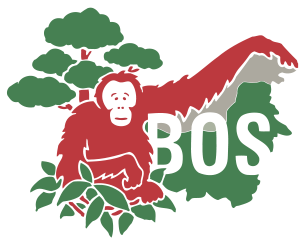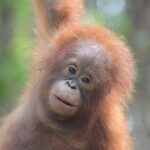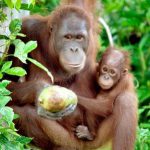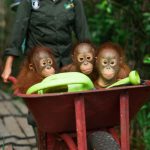LET THE SUNSHINE IN

Saving orangutans also means protecting their rainforest homes and fighting climate change. To reduce our carbon footprint, BOS Australia and BOS Switzerland, together with the BOS Foundation, built a new solar system at our Samboja Lestari rehabilitation centre – our first big step towards renewable energy.
At Borneo Orangutan Survival, we have an ambitious goal: to make all our facilities in Indonesia carbon-neutral, solar-powered, water independent, and self-sufficient in waste-water treatment by 2025. Therefore, we are thrilled to announce that we have completed the first project towards this goal at our orangutan reintroduction centre at Samboja Lestari in East Kalimantan. The new system produces solar energy that will power the centre for decades to come.
Samboja Lestari is home to over 100 orangutans, an eco-lodge, guest education facilities and the head offices for all BOS Foundation rescue, release, and restoration activities in East Kalimantan. However, the centre is remote and therefore not connected to the power grid. Therefore, every year, we had to pump over 100,000 litres of diesel into generators to maintain Samboja Lestari’s vital infrastructure.

From fossil fuels to clean energy from the sun – the solar plant in the middle of the Bornean forest is a flagship project.
As a nature conservation organisation, our goal has always been to move to renewable energy one day. In 2018, the time had come. BOS Foundation, together with BOS Australia and BOS Switzerland, with the help of the Swiss Foundation, started to build a new solar plant.
Now, four years later, the about 850,000 US-Dollar plant is up and running. An over 600-panel solar array alongside the access road to the Samboja Lodge, next to the veterinary clinic, converts sunlight directly into electricity, producing up to 272 kW of renewable energy per hour. With this much solar power, we can drastically reduce our carbon footprint and energy expenditures.
The numbers speak for themselves: Moving forward, we will save more than 100,000 litres of diesel and avoid 150,000 kilograms of carbon dioxide (CO₂) equivalent emissions per year.
While gasoline generators will remain onsite as an emergency backup, we have calculated the energy produced by the solar array to be more than sufficient to provide for all of Samboja Lestari’s energy needs through both the rainy and dry seasons. And soon, we hope to power small electric cars with the system used for most of our daily operations.

A mural by Trio Kune Studio Collective decorates the new solar plant facility. The artists won a competition held by the BOS Foundation with the support of BOS Australia and BOS Switzerland.
To give the project educational value, we added murals to the facility buildings so that visitors learn about solar energy and its economic and environmental benefits. We didn’t leave the design to chance: A jury picked the best idea by running a Mural Art Call amongst Indonesian artists, and the winner, Kune Studio Collective, perfected it. The result was unveiled during the inauguration ceremony on Earth Day, 22 April 2022.
The murals address the connection between protecting climate and species, show how the solar system works, and celebrate the rainforest and its inhabitants. We hope that they will inspire all who see them take their own steps towards renewable energy and greener living.
“The solar project is a dream come true”, says Tony Gilding, president of Borneo Orangutan Survival Australia and one of the forerunners at BOS toward renewable energies. “But we are still far from where we want to be.”
Therefore, BOS Australia and partners were and are expediting other sustainable projects, like converting the former swimming pool at Samboja Lestari’s eco-lodge into a rainwater tank. The 33 metres long, 12 metres wide and two metres deep pool can store up to 1.4 million litres of rainwater. This amount will cover about 20 per cent of the needed 50,000 litres per day used for drinking, washing and food preparation. The rest comes from dams and bore water. The idea is to keep the pool always filled, so there will be plenty of water for fighting forest fires during the dry season – a significant threat to the orangutan population.

Fossil fuels OFF, solar power ON. From left: Dr. Jamartin Sihite (BOSF CEO), Tom Bertinshaw (BOS Australia Project Manager), Moritz Wyss (Representative of BOS Switzerland), Phillip Strub (Deputy Ambassador Switzerland for Indonesia).
But our vision of a carbon-neutral future doesn’t stop at the rehabilitation centres. It continues deep into the Bornean rainforest – with standalone solar power stations.
To be able to monitor the orangutans we reintroduce into the wild, we operate camps close to our remote release sites. Currently, the energy supply for the camps comes from diesel generators. But diesel is not just harmful to the environment; transporting the barrels through rough terrain with roads often undeserving of that term can be a nightmare for our team.
That is why we have started to build the first standalone solar power station for Camp Lesik in the Kehje Sewen Forest in East Kalimantan. With solar energy, we can power all the devices our post-release monitoring teams need with almost zero CO₂ emissions. We will only have to use generators when consecutive days of rain or low light reduce the photovoltaic output or to operate occasional large loads, like heavy power tools, welders, and pumps.
However, moving to solar in remote areas is easier said than done. First, we had to come up with a solution that was efficient for our staff and safe from inquisitive intruders such as orangutans and macaques. Curious as these primates are, they can easily destroy the valuable equipment. So, we need to protect it with fences they can’t access.
“To our knowledge, there is no system like ours that can withstand the rigours of forest life”, explains Tony Gilding. The design incorporates solar panels, inverters, batteries, a backup generator and a solar internet connection. This set-up will give the camp staff hi-speed internet access with no diesel cost or maintenance. It will also allow them to add a fridge to their kitchen. And the extra benefit: By securing the stations with ground screws instead of concrete, we can easily disassemble and transport them to other locations.

An over 600-panel solar array can generate up to 272 kW of renewable energy an hour.
With the pandemic leading to major delivery bottlenecks, the construction of our new solar system started much later than expected, and we could only carry it out under strict safety protocols. Therefore, we are delighted that we could now celebrate its inauguration.
For BOS Australia, the project also has a very personal significance, as the plaza in front of the solar plant facility is named after our president Tony Gilding. It is a token of appreciation in honour of his amazing contribution to orangutan and rainforest conservation and his lead role at BOS in making this move to renewable energy possible.
We like to thank all who have contributed to this project so that the orangutans can benefit from the clean green power of the sun.




